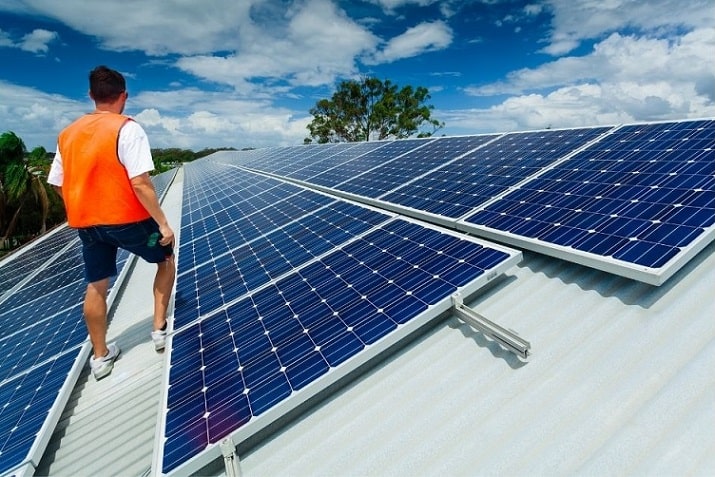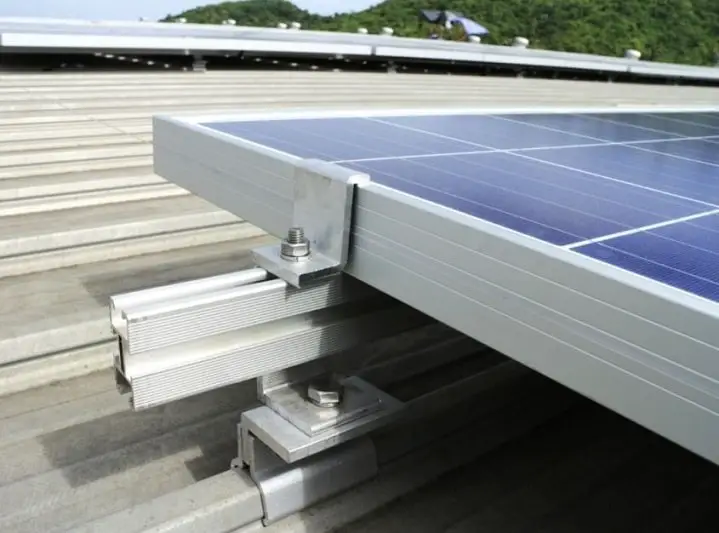Are Pre-engineered Steel Buildings Suitable for Solar Panels?

Solar PV systems are typically installed on rooftops of homes and commercial buildings where space is available. However, is it possible to install them on pre-engineered steel buildings as well?
The answer is yes, it is possible to install Solar PV systems on pre-engineered steel buildings. However, the installation process is going to be different than on a typical building.
You cannot simply drill holes on the roof to install solar panels because this would cause permanent damage to the roof and allow water to enter the building. Therefore you need to follow an installation technique that does not involve drilling into the roof.
Here are a few installation techniques that you can use to install solar panels on pre-engineered buildings. Depending on the type of roof, you can use one or a combination of these techniques to install solar panels on pre-engineered steel buildings.
Clamp-style mounting
Therefore installation is made using special clamps that attach the solar panels to the roof without needing to drill any holes through the steel.
In this setting, the clamp is attached to the roof similar to a hair clip hold. Once the desired holding position is adjusted, the clamp's position is fixated using a locking mechanism usually through fastening with nuts and bolts.
To connect solar panels with clamps often specially designed mounting brackets are used. These brackets are designed to create a connection between the solar panels and the clamp by way of bolting.
Mounting brackets hold solar panels in a fixed position but the connection between the bracket and the panel is again similar to a hair clip hold. During the entire installation process, neither roof nor solar panels are damaged in any way.
That said not all steel roofs are suitable for clamping. In order for clamping to be successful, the roof should have clamping strips. Clamping strips are usually incorporated into the design of steel roofing systems at the time of fabrication to allow for the attachment of clamps.
If there are no clamping strips, then the roof needs to be modified prior to the installation of solar panels. Modifying a steel roof in this way is more expensive than adding clamping strips during fabrication but there is still some other way of installing solar panels on your roof if you are very determined.
Non-penetrating roof mounts
There are special mounts that sit on top of the roof without penetrating it. They secure themselves using gravity and balancing the weight of the solar panels by leaning against the roof.
There are very different types of these roof mounts. They usually come with concrete ballast blocks that weigh them down to prevent the modules from blowing in high winds.
One issue with these systems is the additional load they put on the roof. In order to distribute the additional load, it is better to distribute the ballast blocks evenly across the roof.
Although this type of mount can seem slightly precarious, they do hold solar panels in their positions well.
What to pay attention to installing solar panels on a pre-engineered steel building?
There are important factors to consider when installing solar panels on a pre-engineered steel building.
Clamping Suitable Design
Clamping suitable design is the first and most important factor to take into account. The roof should have clamping strips that allow the installation of clamps for solar panels.

Clamping strips should be present on a majority of steel roofs because they are usually part of the design from the beginning, however, there are exceptions to this rule as well.
Roof Pitch
Roof Pitch is also an important factor consider. Installing solar panels on a low-pitched roof is generally easier than on a high-pitched roof.
Solar panels mounted on a low-pitched roof have fewer restrictions because of their ease of access. But, there are challenges faced when installing solar panels on high-pitched roofs.
The maximum allowable roof load
Roofs in most cases are designed to carry the load of snow, wind, and people walking on them. Introducing additional load from solar panels might change the way the roof handles that load.
Therefore, checking the maximum allowable roof load is necessary to ensure that an extra load from solar panels will not overload or damage the structure of the building.
The weight of the solar panels is important because it works together with the roof's load capacity. In general, the heavier solar panels are, the more pressure is put on a structure and more reinforcement may be required.
Wind Speed
Wind speed is another important factor to consider, as the higher the wind speed, the greater the wind pressure on the solar panel system. To prevent the panels from lifting off the roof, you will need to find a suitable anchoring system that can withstand the wind speeds of your location.
Structural integrity
There are times roof may be sound enough to support solar PV systems but the structural properties of the actual building not. In such cases, you may opt to reinforce or strengthen your building for the job.
Contractor's expertise
Installing solar panels on a pre-engineered steel metal building is easier if you work with a company that has experience working with this kind of structure. Working with steel-framed structures requires the right tools, knowledge of codes and regulations, specialized skills, etc.
Make sure to ask your contractor about their experience working on steel-framed structures. A company knows best how to work with these structures and their expertise can save you time and money.
Installation Warranties
Solar PV systems are not cheap and most people want their panels to last for years. Ensure that your company offers an installation warranty on the products they install.
It is important to ensure that the contractor you hire provides some sort of warranty since unforeseen issues can come up during installation, or after sometime later and damage may occur to the roof and solar panels.
There are different kinds of warranties (e.g., product, installation, performance), and they can be provided to the homeowner, builder/contractor, dealer/contractor, installer, and original equipment manufacturer (OEM).
To find out what kind of warranty your supplier is offering, ask questions about how many years it will cover, who is covered under the warranty, and what workmanship is warranted. In addition, find out what products have been used for the installation, and what brands are involved.
In addition to warranties from manufacturers, you must get a warranty from your contractor. Remember that the term of warranties varies from one company to another, so make sure you know what is covered and for how long by asking questions.
Corrosion Issues
Steel-framed structures are vulnerable to corrosion. This is because the metals used in steel-framed structures react with oxygen and water to form rust, which spreads quickly if left untreated.
Installing solar panels on your pre-engineered metal building will require additional work to be done on the roof that may encourage corrosion. This is why it is important to check with your contractor about their installation procedure and whether or not they use corrosion-inhibiting materials like primers and paints.
In addition, you should also check with your supplier about the materials used in the panels as well as how the installation was done. You can also check your warranty to see if it will cover corrosion-related issues and what the limitations and exclusions are.
Conclusion
Installing solar panels on a pre-engineered building is viable if you use the right installation technique that will not damage the roof. You need to pick a contractor that has experience working with metal structures and check their warranty, installation procedures, and workmanship.



